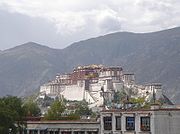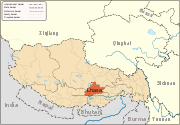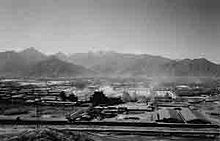- Drapchi Prison
-
"Drapchi" redirects here. For the upcoming film, see Drapchi (film).
Drapchi Prison, or Lhasa Prison No. 1 (simplified Chinese: 拉萨第一监狱; traditional Chinese: 拉薩第一監獄) is the largest prison in Tibet, located in Lhasa.
Originally built as a Tibetan military garrison, Drapchi was transformed into a prison after the 1959 Tibetan uprising.[1]
It officially opened as a prison in 1965 and consists of a series of nine units and has recently been expanded and restructured. It has an estimated population of 1000 of which some 600 are thought to be political prisoners ranging in age from 18 to 85 many of which are captured monks and nuns.
According to Central Tibetan Administration, the prison has gained a notorious reputation and is feared by the Tibetans due to its strong management. Reports of brutality have been alleged by Tibetan exile groups.[2]
In November 1994, 13 nuns were send to Drapchi to serve a 5-year sentence for endangering state security by protests against the Chinese rule in Lhasa. In April 1996 all the inmates of Unit 3 of Drapchi prison, consisting of nearly 100 female political prisoners, went on a hunger strike in protest of the harsh treatment they were receiving in Drapchi. The week long strike caused the prison officers some concern that it might damage the reputation of the prison further if the inmates died as a result and promised an end to the brutality.[3]
Notable inmates
References
- ^ Staff. "Drapchi Prison : Tibet's Most Dreaded Prison: An Insight into Drapchi Prison: History of Drapchi Prison". Tibetan Centre for Human Rights and Democracy. http://www.tchrd.org/publications/topical_reports/drapchi_prison-2001/#history. Retrieved 2010-02-03.
- ^ Political Prisoners[dead link]
- ^ "Testimony given by Passang Lhamo, Tibetan nun and former political Prisoner, to the U.S. Congressional Human Rights Caucus". Government of Tibet in Exile. May 6, 2002. Archived from the original on August 19, 2007. http://web.archive.org/web/20070819034526/http://www.tibet.com/NewsRoom/drapchipassang.htm. Retrieved September 23, 2008.
External links
Lhünzhub · Damxung · Nyêmo · Qüxü · Doilungdêqên · Dagzê · Maizhokunggar · Chengguan District


Towns and villages Monasteries
and palacesArchitecture of Lhasa · Lingkhor · Potala Palace · Norbulingka · Jokhang Temple · Tsomon Ling · Ganden Monastery · · Kundeling Monastery · Nechung · Nyethang Drolma Lhakhang Temple · Yangpachen Monastery · · Drepung Monastery · Ramoche Temple · Reting Monastery · Sanga Monastery · Yerpa
Sera Monastery: · Chupzang Nunnery · Drakri Hermitage · Garu Nunnery · Jokpo Hermitage · Keutsang Hermitage · Keutsang East Hermitage · Keutsang West Hermitage · Khardo Hermitage · Negodong Nunnery · Nenang Nunnery · Pabongkha Hermitage · Panglung Hermitage · Purbuchok Hermitage · Rakhadrak Hermitage · Sera Chöding Hermitage · Sera Gönpasar Hermitage · Sera Utsé Hermitage · Takten Hermitage · Trashi Chöling HermitageOther landmarks Banak Shöl Hotel · Barkhor · Chokpori · Drapchi Prison · Lhasa Brewery · Lhasa Hotel · Lhasa Zhol Pillar · Tibet Museum · Tibet University · Tromzikhang · Nyang bran · Hutoushan ReservoirTransport Lhasa Airport · Damxung Railway Station · Lhasa Railway Station · Lhasa West Railway Station · Wumatang railway station · Yangbajain Railway Station · G109 · G318 · North Linkor RoadGovernment Doje Cezhug · Jigme Namgyal
Coordinates: 29°40′11″N 91°08′11″E / 29.6698°N 91.1364°E
This Chinese prison-related article is a stub. You can help Wikipedia by expanding it.

